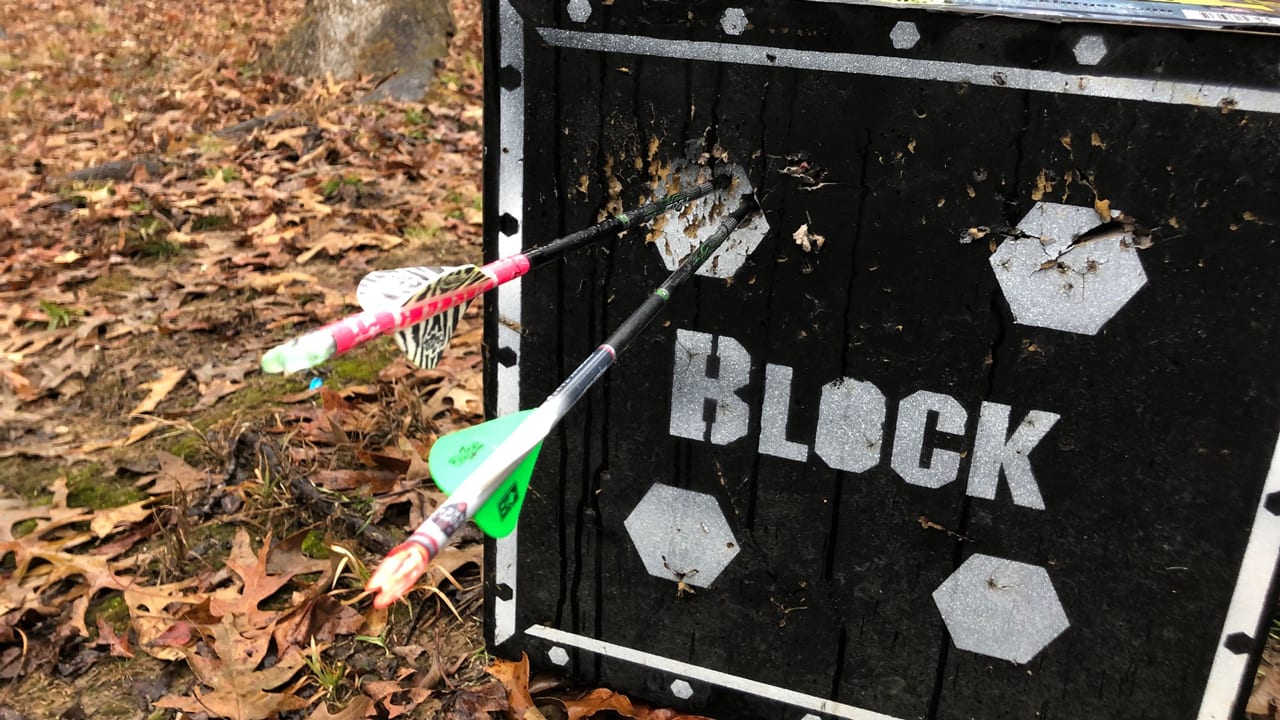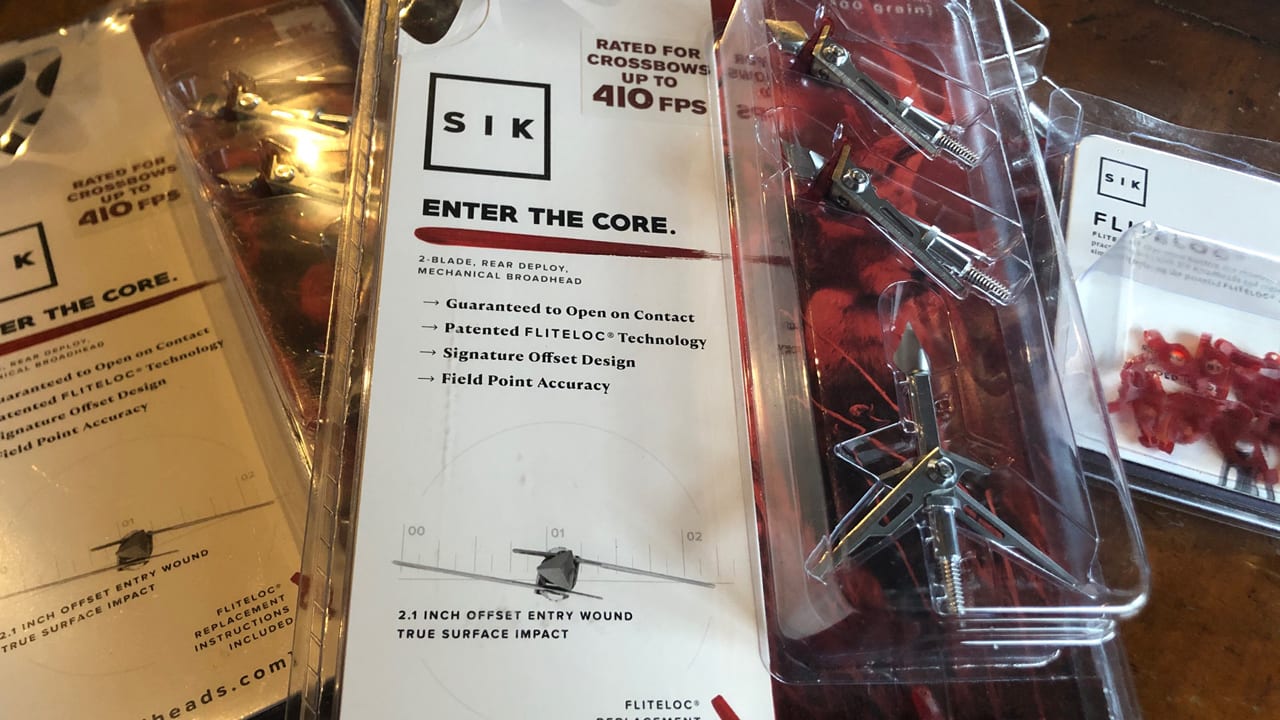One of the newest broadheads on the market is the SIK SK2 broadhead. Obviously, the brand name, SIK, conjures up all types of deadly and destructive thoughts in the mind of a bowhunter, but I wanted to take a closer look at this new head and put it to the test for myself on deer at home in west Tennessee. Here’s a look at what I found in this new broadhead in our SIK SK2 Broadhead Review.

Meet the SIK SK2 broadhead.
Out of the Package
The SIK SK2 broadhead is a rear deploying head that comes in a 3-pack. You’ll know you’re holding something uniquely different the moment you pull these heads from the package. They’re like nothing else I’ve ever seen. From their offset blade design to their FliteLoc Clips to ensure deployment, these heads are proof this company has stepped far outside the box in broadhead design.
First Impressions
The first thing that caught my eye with these broadheads are the red FliteLoc clips. I’m always skeptical of any new add-ons, clips, rings or other gadgets required by a broadhead. But after giving it a further look, the FliteLoc Technology concept makes since. Better yet, it works. I didn’t have any malfunctions or accidental deployment of the blades throughout the testing process.
The other aspect of the head that will immediately grab your attention is the offset blade design. The design was intended to make a dramatically deadlier cut upon impact. The offset nature of these blades results in a z-pattern, or lightning bolt shaped cut, for an incredibly devastating wound channel.
Basics on the SIK SK2 Broadhead
As mentioned, the heads come in a 3-pack. They are a 100-grain, 2-blade mechanical head designed to produce a 2″ offset entry wound and over 3.625″ cutting surface overall. They are being touted as a field-point accurate broadhead. The company says the head’s FliteLoc clip guarantees the head to open on contact, and they are priced at $49.99 per pack.

The offset design of the SK2 delivers destruction.
SIK SK2 Performance
My first move was to put these broadheads into some foam to see if they would in fact live up to their claim of being field-point accurate. With such a crazy offset design, I had my doubts as to how they might fly. However, a few shots into the Block target and I realized these heads held their own when it came to arrow flight. The SK2 flew a little right of my field-point arrow at 20 and 30 yards. We’ll spend more time with them in the days ahead to see how they handle longer distances down range.

The SIK head flew just to the right of my field point when tested at 20 and 30 yards.
What I was more interested in was to see how these new heads would perform on live targets. I hit the woods with a quiver full of the SK2 broadheads in search of a doe or two that might slip within bow range of my stand. I didn’t have to wait long after climbing into the stand before a couple prospects came through the woods in my direction. I let a young buck walk past my stand as I focused my attention on his sister. I was at full draw when she stepped out from behind a tree just 15 yards away. When I dropped the string, the arrow zipped through the deer and buried up in the dirt a few yards away, sending deer running in several directions. The deer I shot couldn’t keep up with the rest and tipped over at the edge of the the field after a short run through the timber.
Although I didn’t need to, I followed the bloodtrail to the deer to get an idea of what the offset blade design of the SK2 might produce. The trail was excessive and easy to follow. I knew I had hit her really good, so I wasn’t all that surprised at the bloodtrail that led to my deer. But what did surprise me was the wound channel I found at the end of the trail.

My first deer shot with the SIK SK2 head left little room for doubt as to the legitimacy of this new broadhead design.
The wound I found on this deer was about as nasty as they get. It certainly created the advertised 2″ hole, and then some. But because of the offset blade design, it wasn’t just a 2″ slice in the side of this deer. It was a gaping hole that no deer could handle. It’s the kind of wound you want a broadhead to create. It’s the kind of hole that’ll save you on a marginally hit deer. I was impressed with what I found on my first animal killed with the SIK SK2 broadhead.

The SIK SK2 lives up to its claim for making a ridiculous wound upon target impact.
Some Assembly Required
I honestly couldn’t find much that I didn’t like about these broadheads. They are simple to use and seem to hold up well, even after multiple shots into the target. You will have to add another FliteLoc clip to the head after each shot. But it’s not a big deal, especially since you can buy the clips in a package of 12 for replacing after practice or success in the field.
Adding the clips is very simple, but it does require you to remove the tip (tip screws on and off) and replace the FliteLoc clip, with blades lined up to fit the slots in clip. Again, it’s not a big process, but it does take some quick assembly when replacing the clips.

The FliteLoc design on the SIK SK2 is quick and easy to install, but does require some light assembly.
How confident is the company with this new design concept? The company is so sure of its blade retention design that they’ve rated the SIK SK2 strong enough for crossbows up to 410 feet per second. And that’s a pretty strong statement for a mechanical head.
Be sure to check out the SIK SK2, as well as the rest of the lineup of SIK broadheads, at www.sikbroadheads.com.

 By
By 




